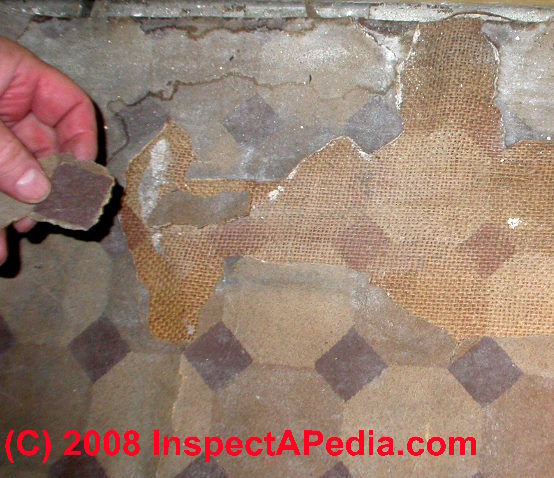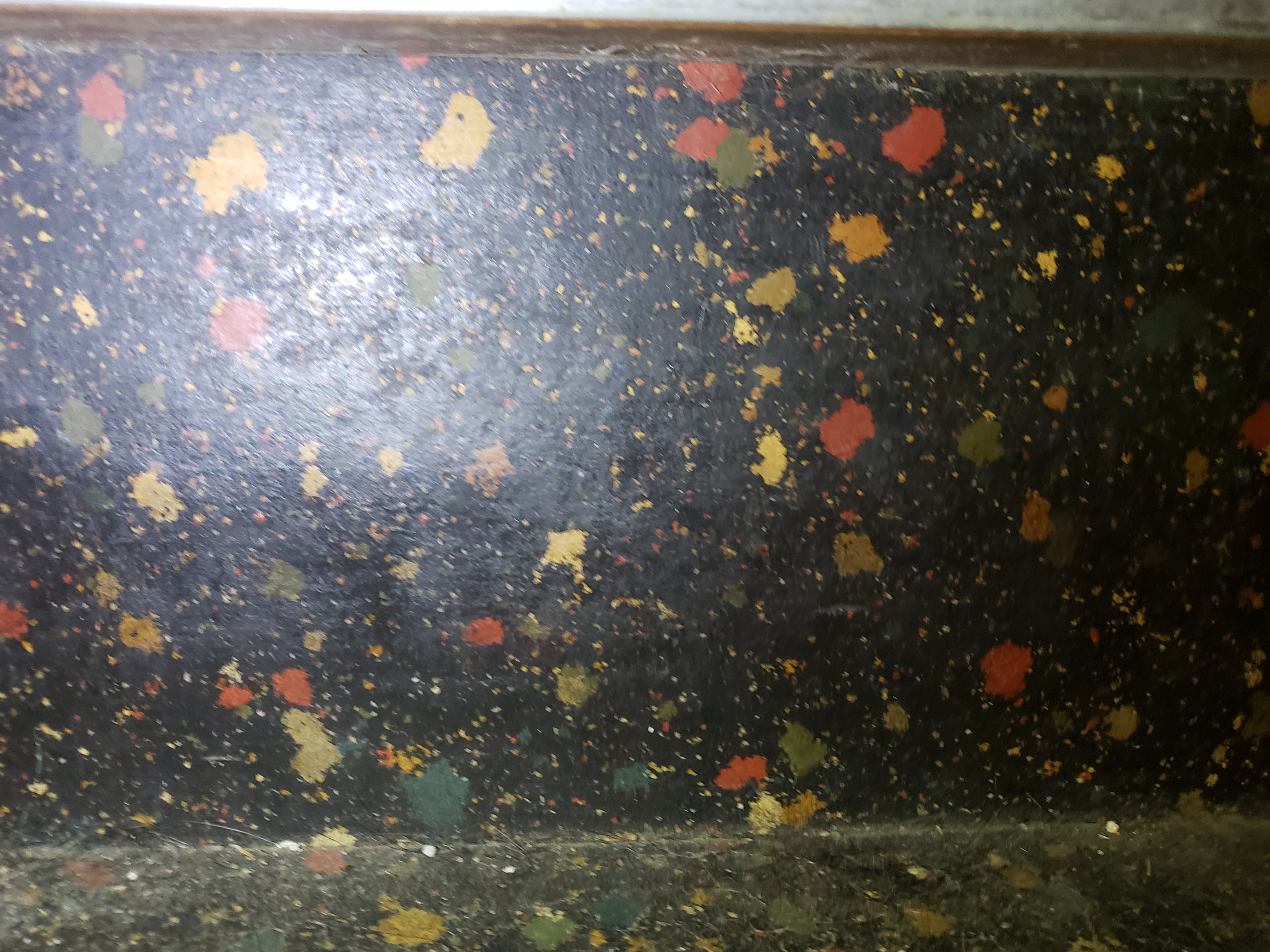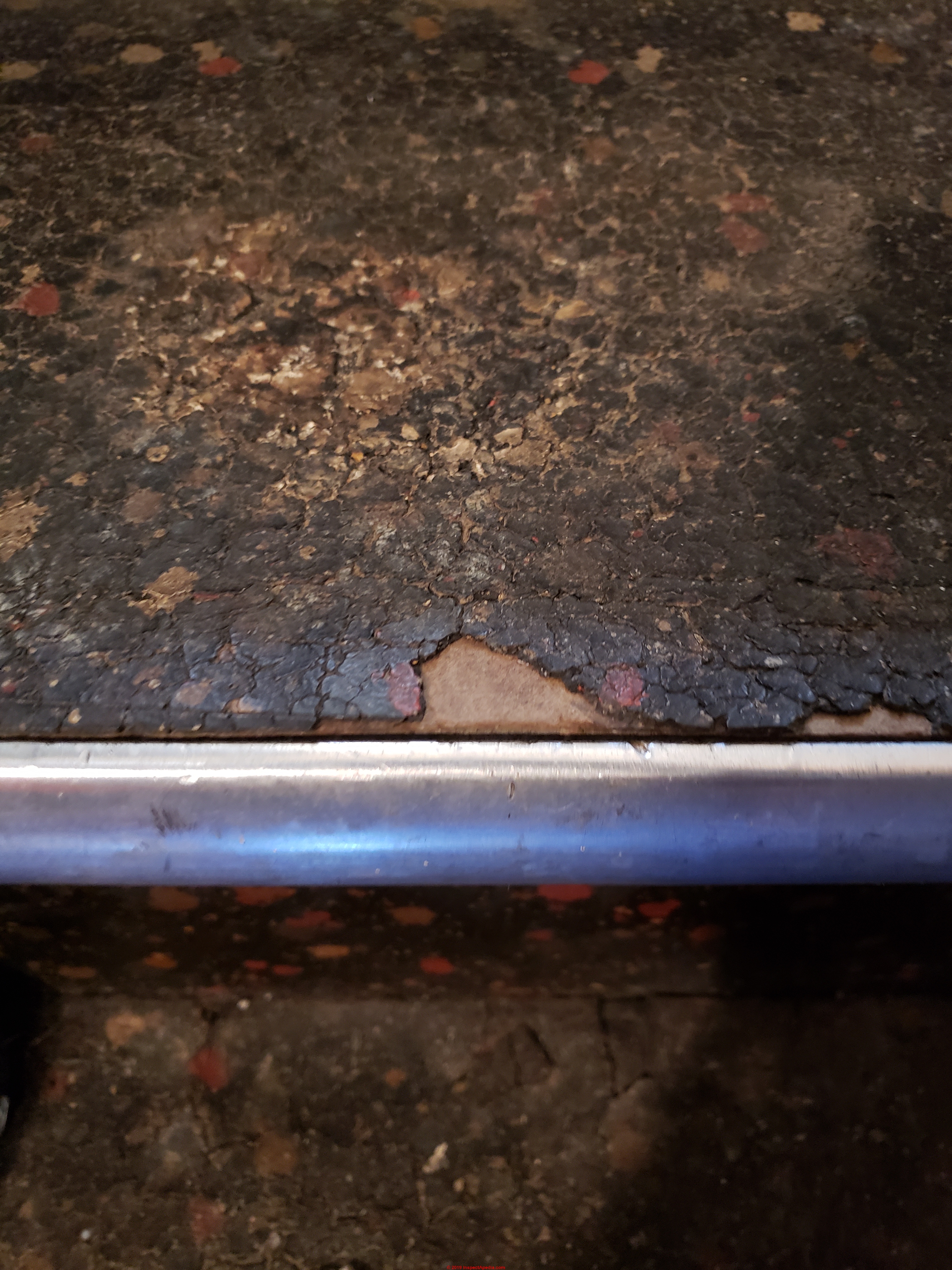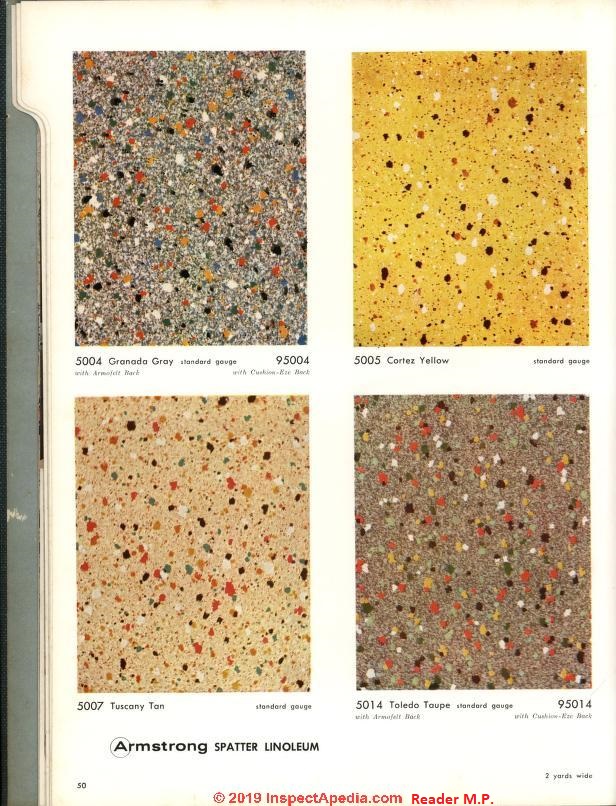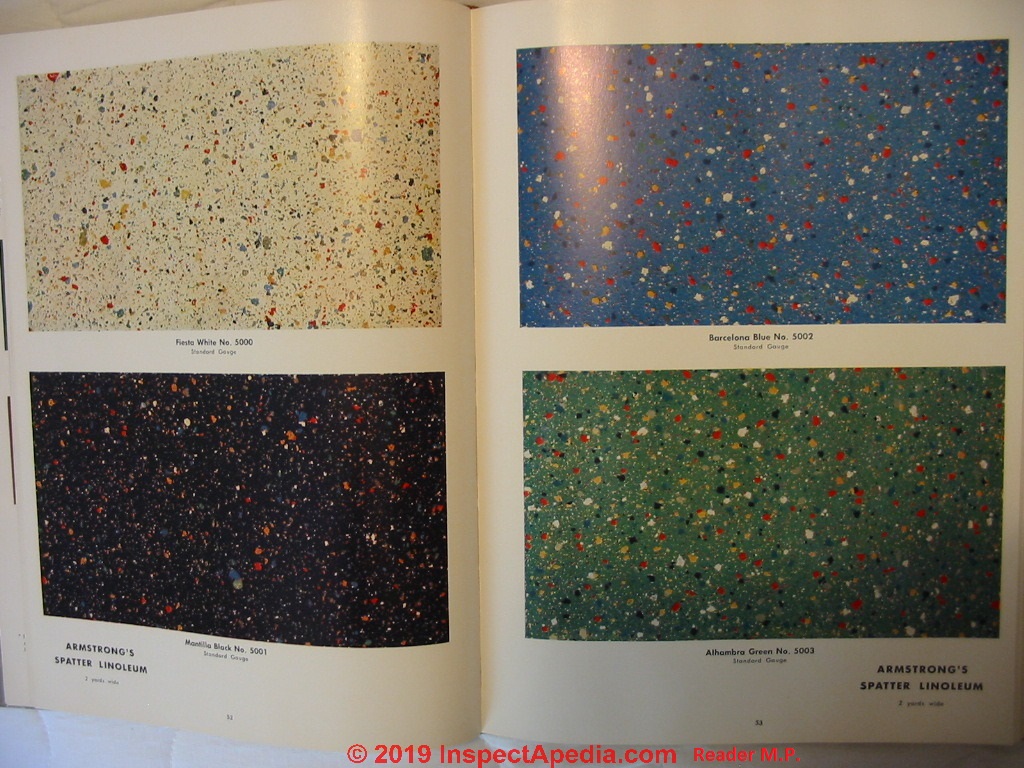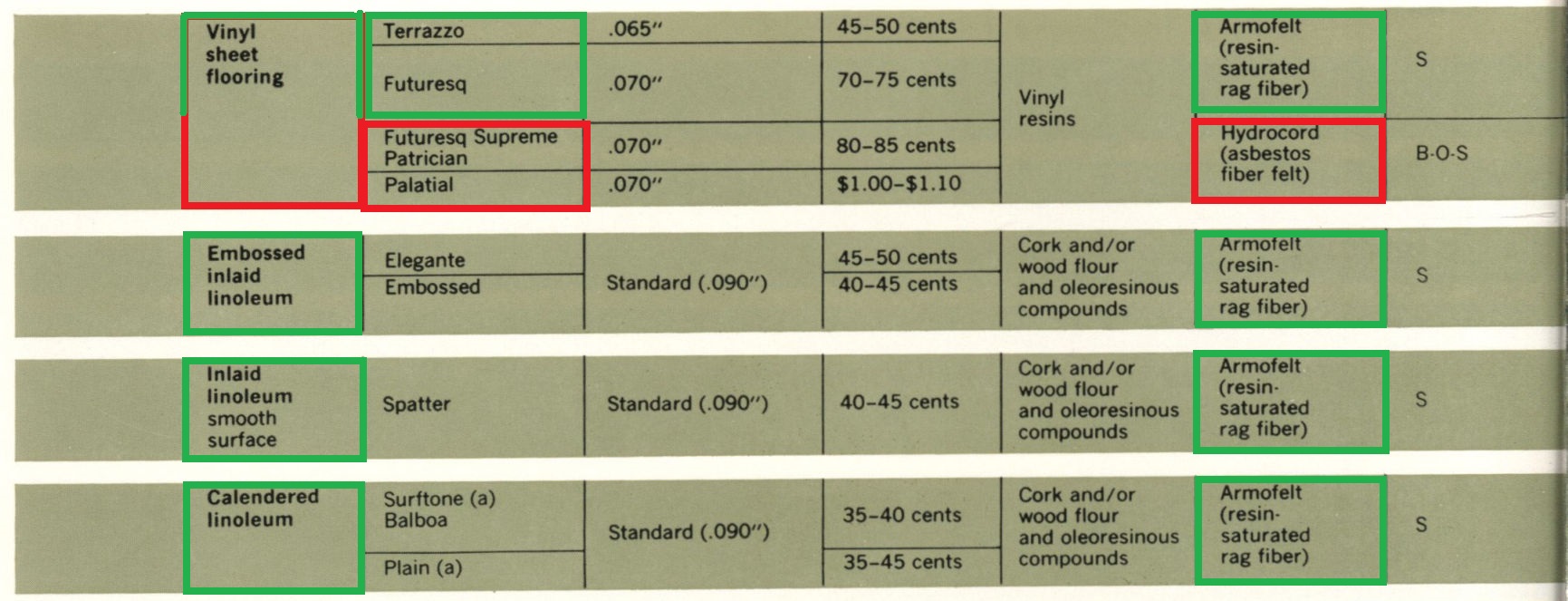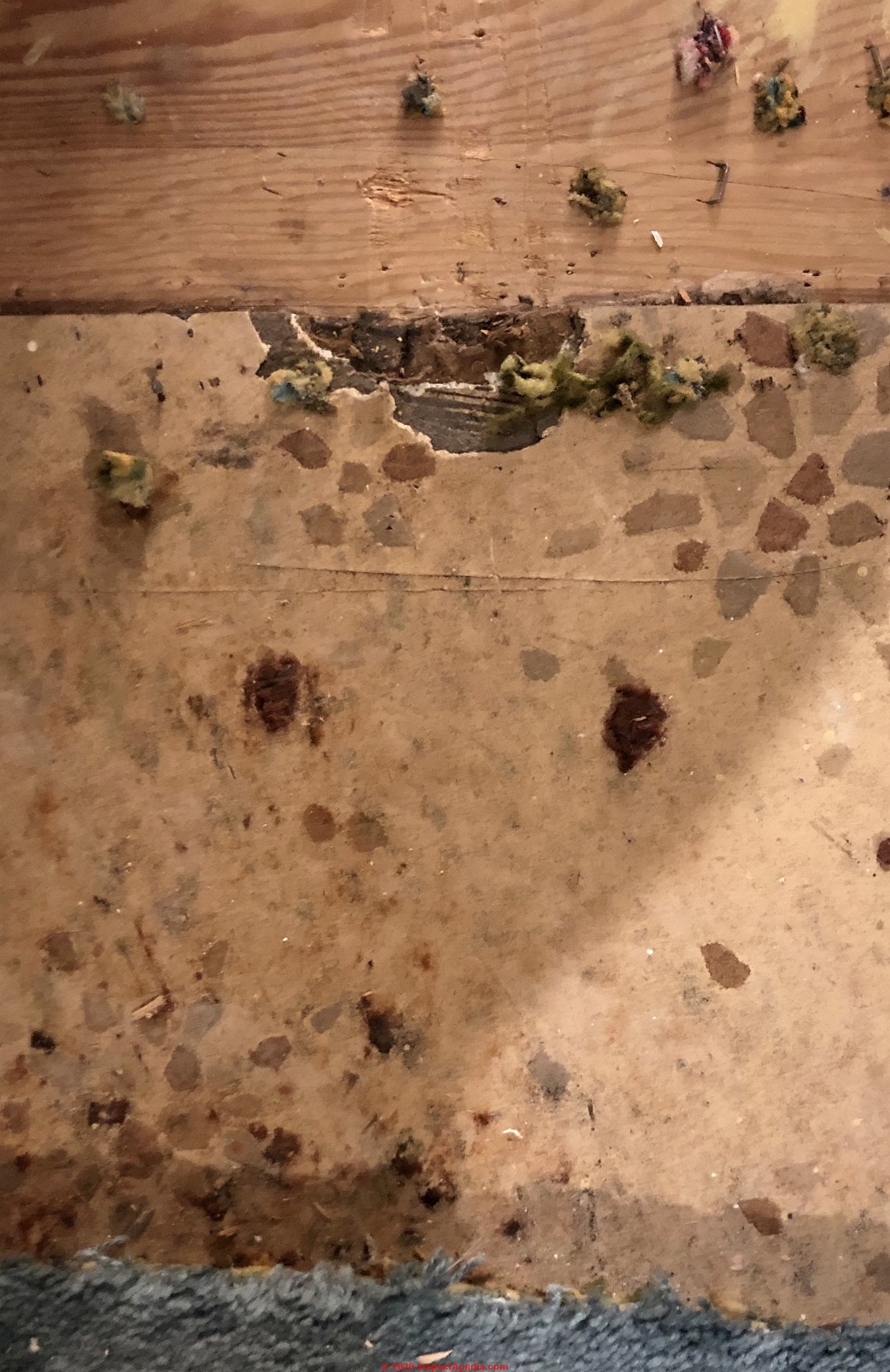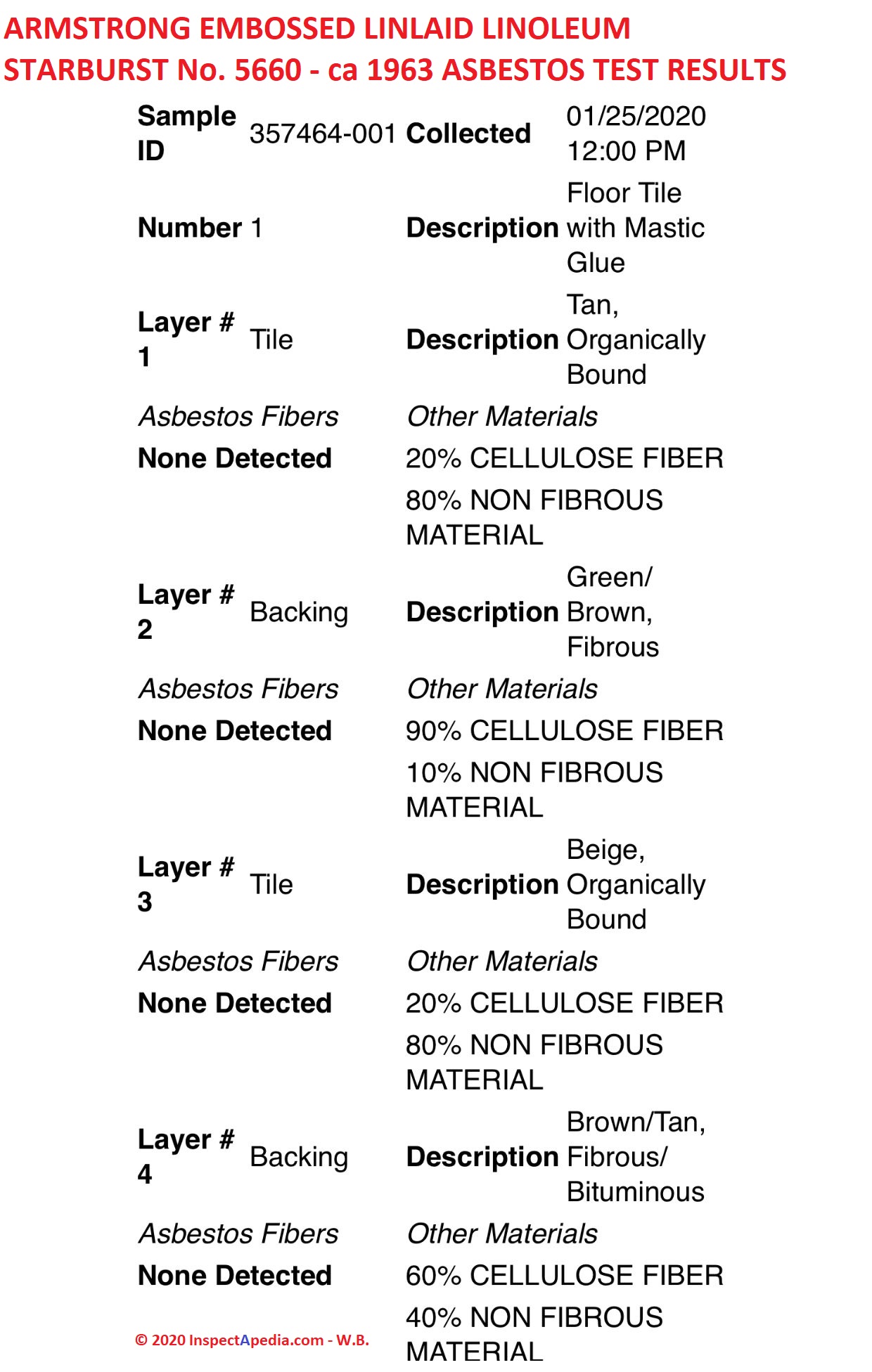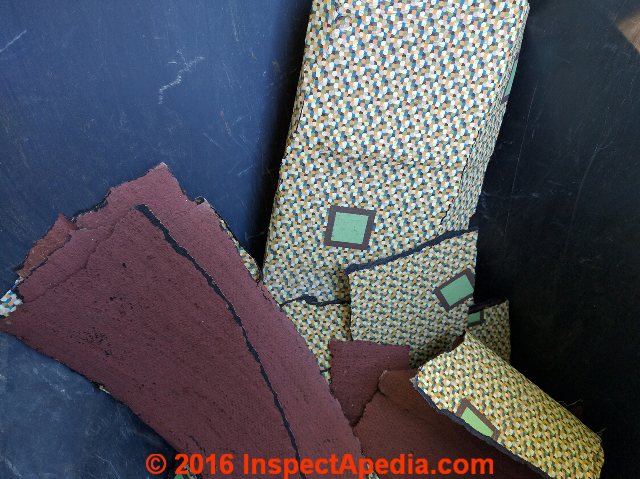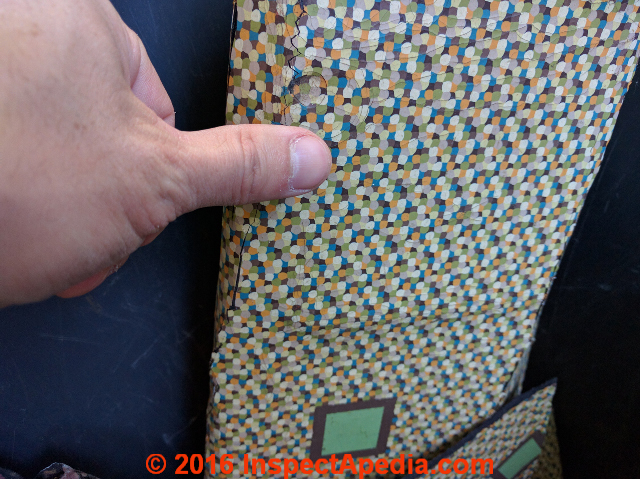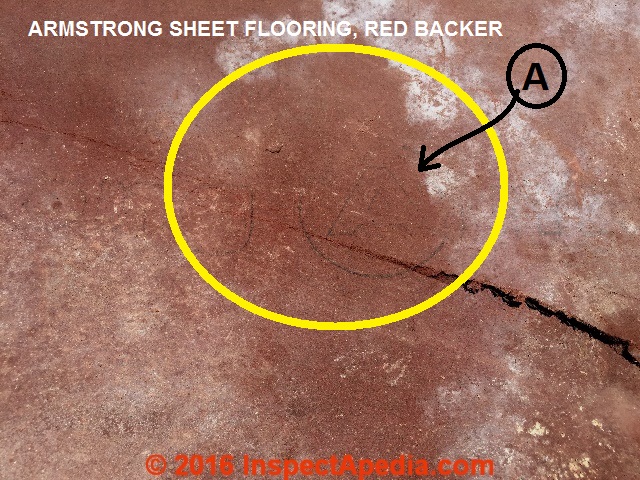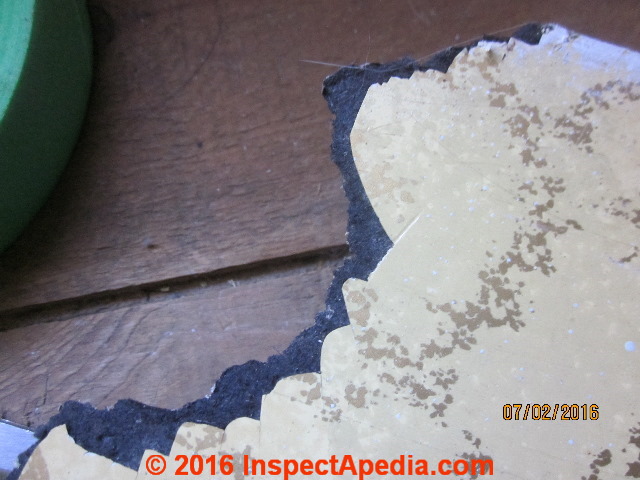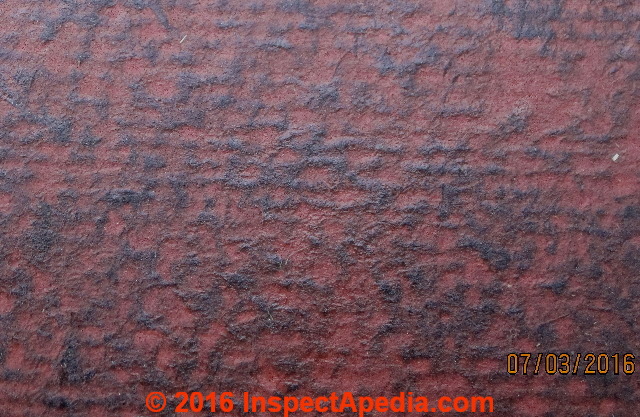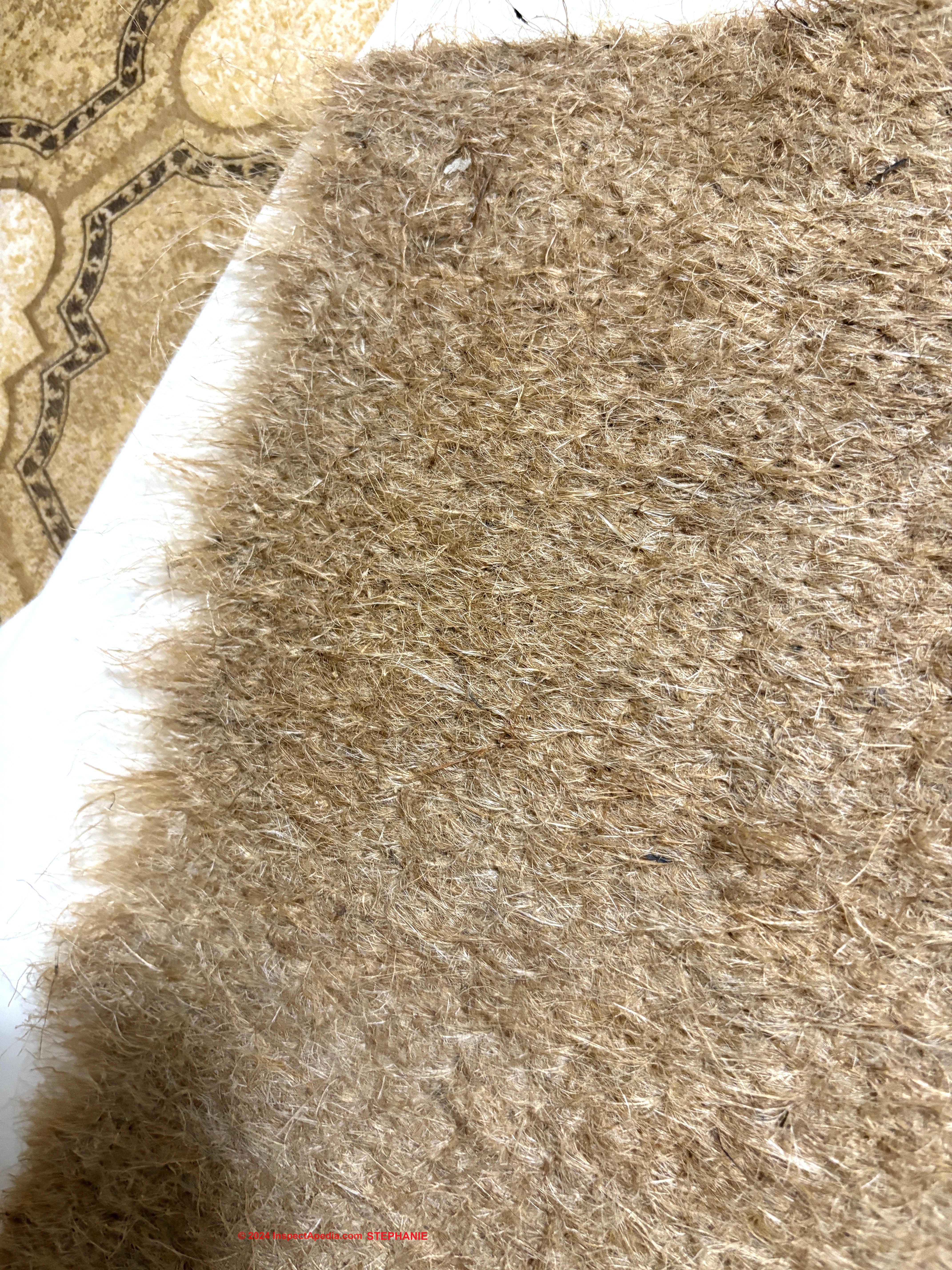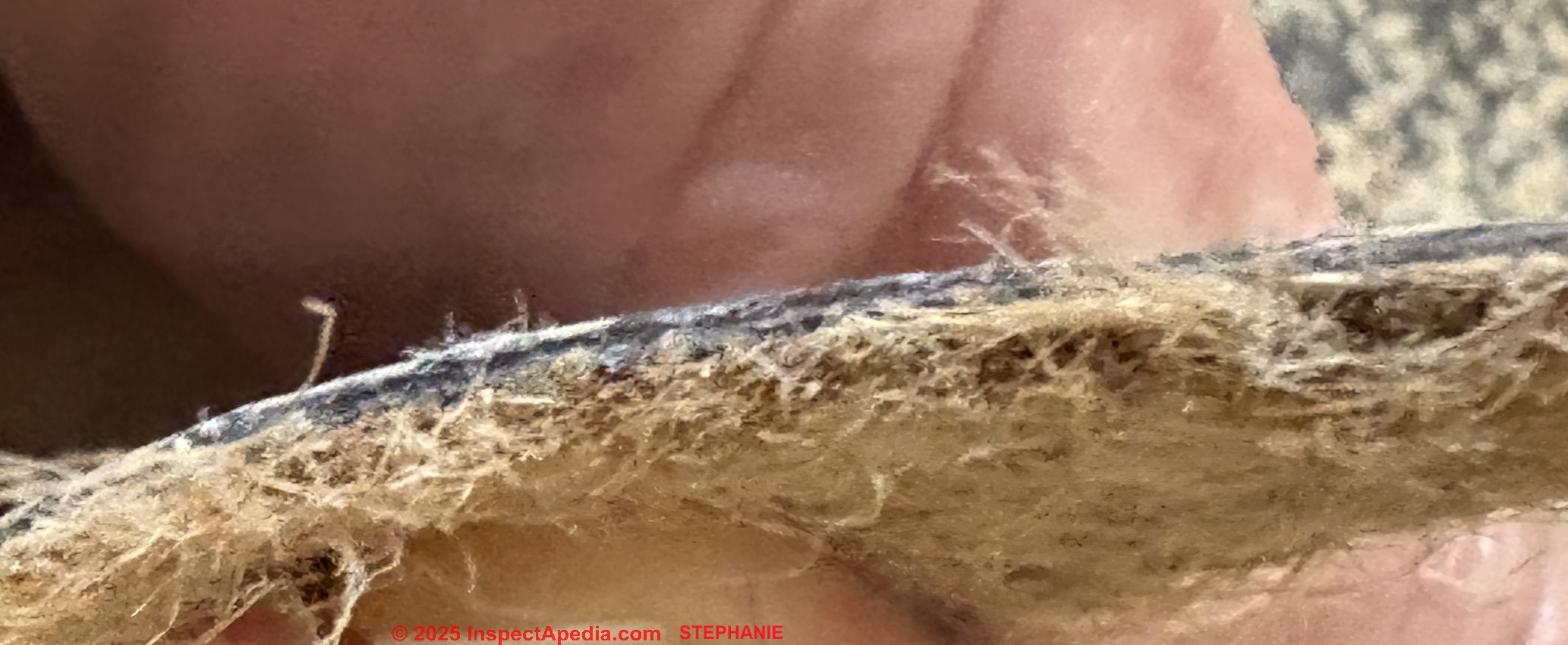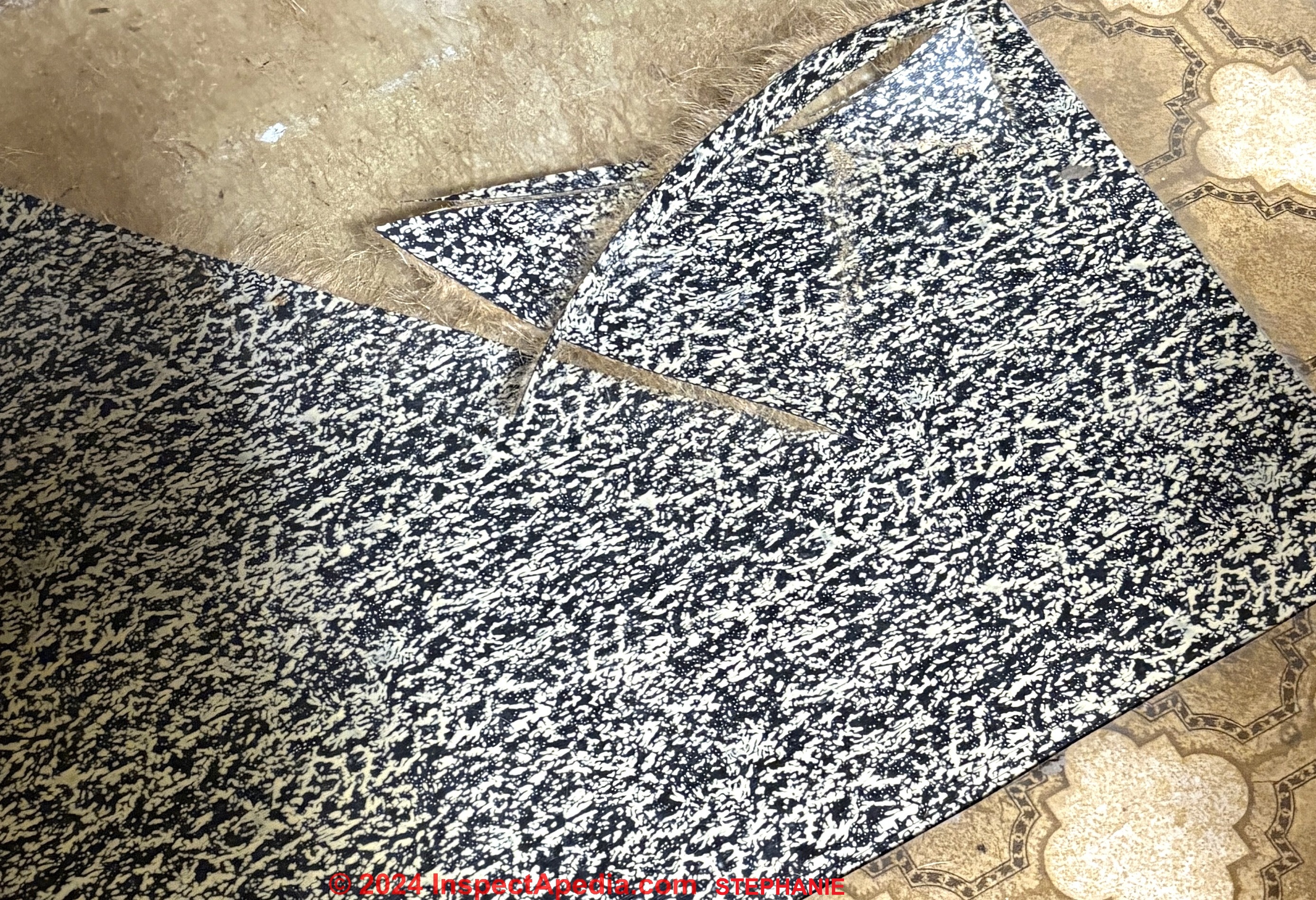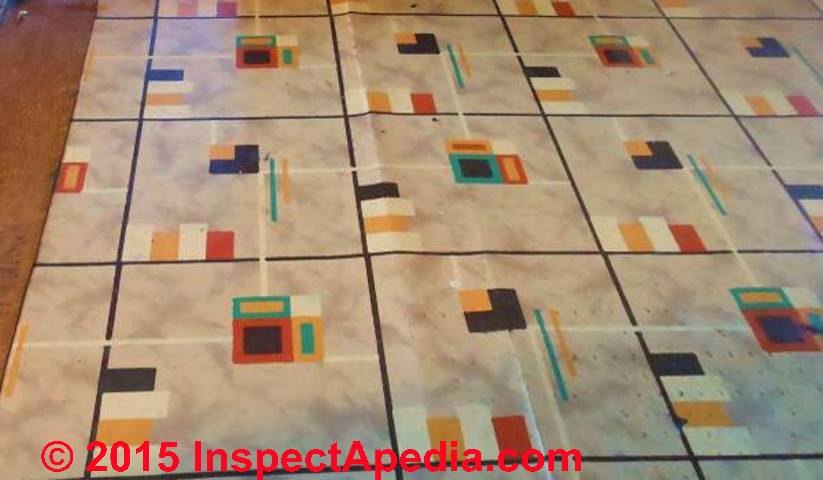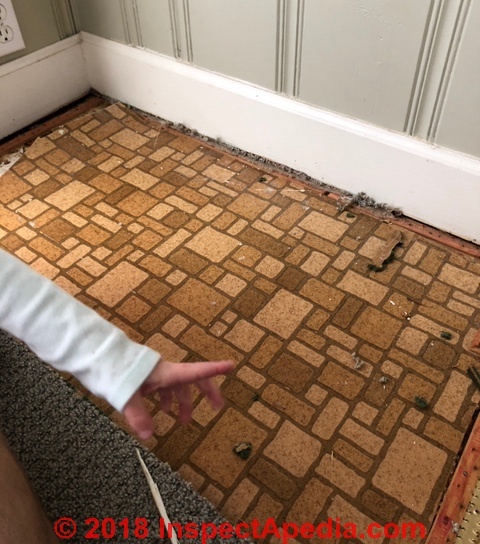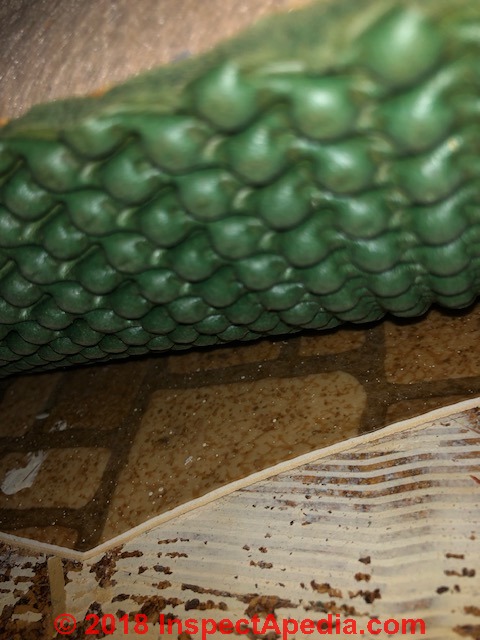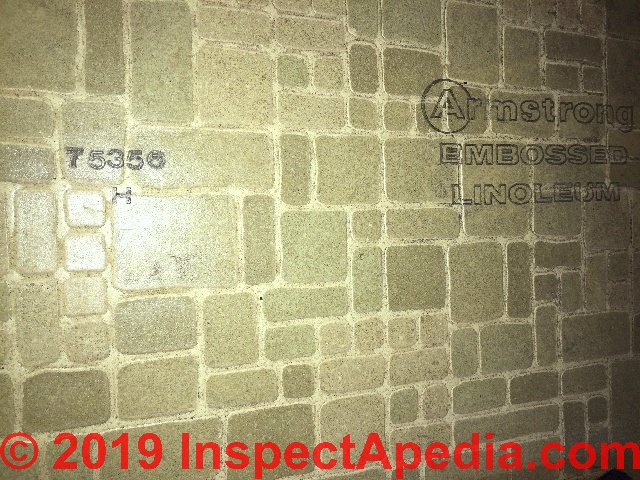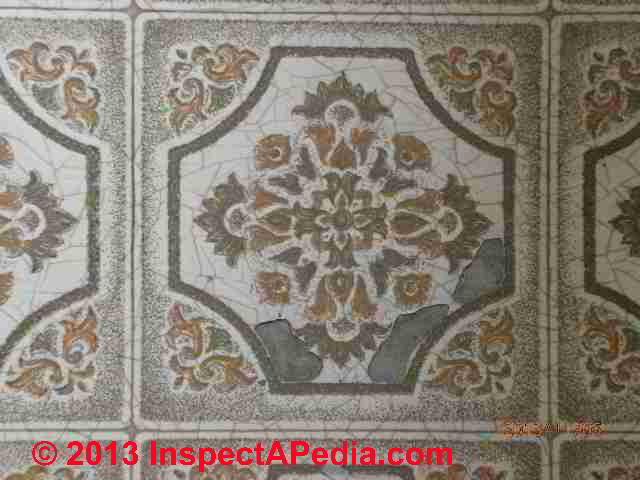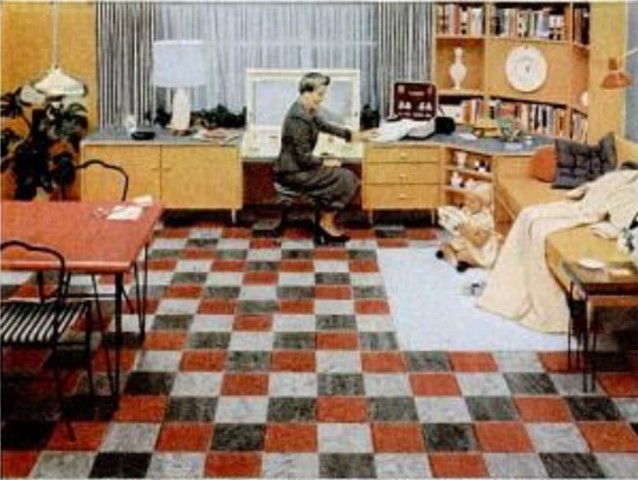 Non-Asbestos Resilient & Sheet Flooring
Non-Asbestos Resilient & Sheet Flooring
Identify Resilient or Sheet Flooring that Does Not Contain Asbestos
- POST a QUESTION or COMMENT about sheet flooring products that might contain asbestos
Non-asbestos sheet flooring or resilient flooring product identification:
How to recognize several sheet flooring or resilient flooring products that do not contain asbestos. This article describes non-asbestos-containing floor coverings including linoleum and some Armstrong and Congoleum sheet flooring products and unbranded asphalt-impregnated paper-backed sheet flooring, asphalt-core sheet flooring, asphalt based sheet flooring, and rubber-backed sheet flooring that usually does not contain asbestos.
This article series describes sheet flooring products known to contain significant levels of asbestos. We also include photographs for identification of known asbestos-containing resilient sheet flooring as well as unknown flooring submitted for identification. The article gives safety and asbestos testing advice for sheet flooring products.
InspectAPedia tolerates no conflicts of interest. We have no relationship with advertisers, products, or services discussed at this website.
- Daniel Friedman, Publisher/Editor/Author - See WHO ARE WE?
Examples of older sheet flooring that Does Not or is Unlikely To Contain Asbestos
Shown at above, jute-backed antique sheet flooring from a pre-1900 historic home. This floor covering does not contain asbestos.
Article Contents:
- ARMSTRONG ARMALON SHEET FLOORING
- ARMSTRONG EMBOSSED INLAID LINOLEUM 1963
- ASPHALT BASED SHEET FLOORING
- BURLAP / JUTE - BACKED SHEET FLOORING
- LINOLEUM COMPARED to VINYL FLOORING
- VINYL SHEET FLOORING, NON-ASBESTOS
- RED-UNDSIDED FLOORING PRODUCTS
...
Armstrong 5000 Series Spatter Linoleum - 1950s: probably not asbestos
[Click to enlarge any image]
Does this 1951 Sheet Flooring Contain Asbestos?
This sheet flooring has been exposed in my parents' house on the stairs leading to the basement. It has been there for my whole life (I'm 19), and only recently did I realize that it might contain asbestos.
I have attached 3 photos, one of the stairs in general, one of an exposed part of the backing, and one with a section of the flooring turned over.
I took off a piece of the paper-like backing and tried to burn it. It smokes and chars, but does not hold a flame. We are possibly going to get it tested soon, but I would still like a professional opinion.
Not only am I concerned about that area, but I discovered the same flooring in the hallway on the main floor.
We had new carpet installed today, but we decided to do the removal ourselves, which involved scraping old carpet padding off of these floors.
There are a few spots where the black upper part is gone leaving the backing exposed. I can't get pictures of this as the new carpet is already installed over it.
The house was built in 1951, and the flooring is original.
I'm very worried as the basement stairway is a well-traveled area and we are walking over this stuff daily.
[This discussion began at IDENTIFY SHEET FLOORING TYPE, HOW TO and is included and expanded upon here - Ed. ]
Reply:
From the spatter pattern and colors this flooring could be as old as the home, I agree.
While I can't be certain from just what I can see, when there is a white backer on older sheet flooring, in my experience it can indeed contain asbestos.
Until you have the test results from an asbestos test lab (see ASBESTOS TESTING LAB LIST ) if you avoid creating a dusty mess (grinding, chopping, sawing, sanding) the floor, you will minimize the risk of sending potentially harmful dust about your home.
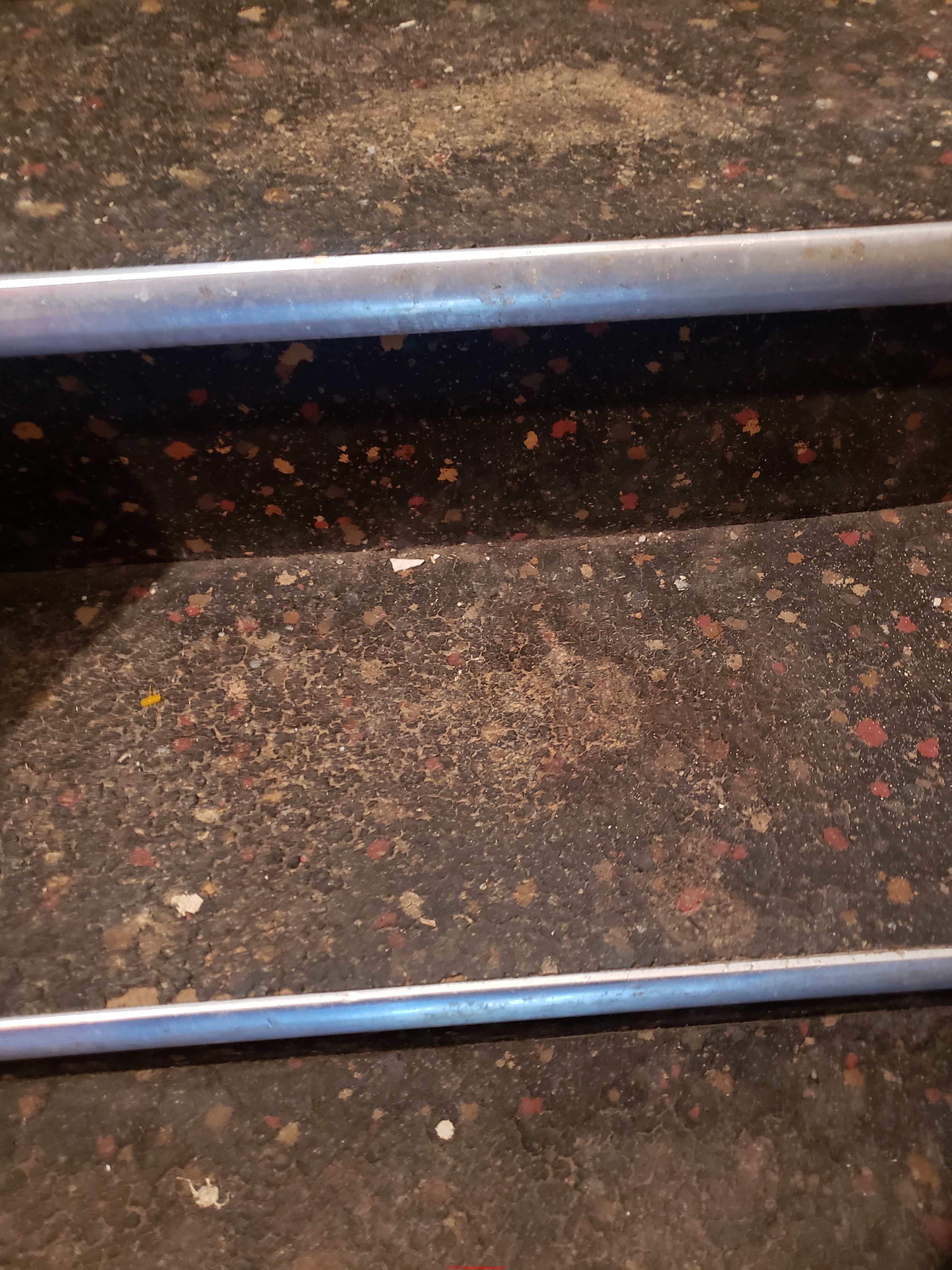 I would be grateful to see a copy of the lab test results and for your OK to add these photos to our online ID library; Our default is to keep your personal information private unless you ask otherwise.
I would be grateful to see a copy of the lab test results and for your OK to add these photos to our online ID library; Our default is to keep your personal information private unless you ask otherwise.
It would also help to know the country and city of the home.
Reader follow-up:
My home is located in Milwaukee, Wisconsin. Also, you're certainly welcome to use my photos on your website.
I have just a few more questions. Just walking on the steps wouldn't cause the material to become airborne, correct? I know that the black upper portion is cracking from wear, but as long as I'm not cutting it and creating dust, is it fine to walk on?
Is the backing and upper portion friable? My googling has produced mixed responses. Some sources say sheet flooring is friable while tile is not. When I tore off a small corner of the backing to see if it burned, it required a fair bit of effort.
Would the backing still burn even if it had asbestos?
Finally, would you advise carpeting over the steps? I would glue down the tack strips to avoid disturbing the material if I decide to go that route.
I will follow up later with test results. I've been quite busy lately so it may be a while.
Moderator reply:
I don't think there's much risk from walking on the old flooring as long as it's basically staying in place. [Watch out: asbestos-suspect floor coverings that are crumbling or breaking up are more hazardous.]
And I agree that covering over with new material is the safest, most economical, and most recommended solution.
 You can cover it with carpeting or you could cover it with new sheet flooring. Gluing the tack strips is a great idea for reducing the risk of unnecessary disturbance although in my opinion the potential asbestos release from nailing attacks trip through old flooring to subfloor below is almost certainly beneath the limits of detection.
You can cover it with carpeting or you could cover it with new sheet flooring. Gluing the tack strips is a great idea for reducing the risk of unnecessary disturbance although in my opinion the potential asbestos release from nailing attacks trip through old flooring to subfloor below is almost certainly beneath the limits of detection.
About friability in general,
"Friable" means that you can crush a material between thumb and forefinger to produce a fine powder that could become easily airborne. That's not the case with flooring products.
The dust hazard more generally comes during demolition, grinding, chopping, etc. as I warned before.
Your photos and our brief comments are online at
As it will be helpful to other readers, and as its publication may prompt other readers to offer a helpful suggestion, I will include a redacted (to respect your privacy) version of this discussion in our article at
IDENTIFY SHEET FLOORING TYPE, HOW TO
near the bottom of that article.
Reader follow-up:
I have one more question.
Is it just the backing that could contain asbestos, or could the upper black part contain some too? I ask because we had to scrape some old carpet padding off the top of the floors (the black patterned portion).
We used a putty knife and a hammer to scrape the padding up, but we only scraped the upper surface of the floor (not the backing).
Did we release any fibers this way? We also vacuumed the upper surface because it was incredibly dirty, and this has me concerned as well.
Moderator Reply:
If the flooring backer contains asbestos the potentially significant hazard would occur during an aggressive, dust-creating demolition such as involving chopping, grinding, sanding, sawing the material. Note that if the flooring is glued down, some flooring cut-back or mastic adhesives also contain asbestos.
If such flooring is not glued down it can often simply be rolled up and bagged for disposal as construction debris (with rules varying depending on where you live). If the flooring is adhered and must be removed (just covering it over is better) then you'd either treat the floor as presumed to contain asbestos (PACM) or you'd have a sample tested.
IN sum, at this point, to ease your concern you'd best collect a representative sample of settled dust to have examined for asbestos.
Reader Follow-up: Armofelt & Cushion-Eze Resilient Floor Backers probably not asbestos
2019/11/13 InspectApedia.com reader M.P. wrote:
From careful inspection of the pattern on the stairs' riser (where the flooring is less worn), I believe with near certainty that this flooring is part of Armstrong's Spatter Linoleum series of sheet flooring, specifically No. 5001 "Mantilla Black".
I have included a picture of a period-correct catalog from Armstrong with this pattern and other colors in this series.
Not much literature exists regarding this specific series of flooring, but I researched further and found another 1957 Armstrong catalog with the same 5000 series linoleum floors, and I have included images of this as well.
As you can see, this specific series of linoleum floors were installed with Armstrong's exclusive "Armofelt" backing, or with the optional "Cushion-Eze" foam backing; both of these materials do not contain asbestos.
I cannot find any source indicating that this specific series of linoleum sheet flooring was ever available with Armstrong's "Hydrocord" asbestos-containing backing.
Some styles of Armstrong vinyl Corlon sheet flooring also included the asbestos-free Armofelt backer in addition to asbestos-containing Hydrocord.
Armofelt is proving to be an elusive topic of research, but I have found an archived 1962 Armstrong technical data book with a wealth of information regarding it and other types of Armstrong flooring material. [Link and PDF copy given below].
It appears Armofelt is usually the backer material of choice for floating subfloors (like stairs), while Hydrocord is most often adhered to concrete subfloors due to it's alkali and moisture resistant properties.
Also, and perhaps most importantly, there is a table on page 8 [sic - we are researching this - Ed.] indicating that the only backing material available for inlaid smooth-surface linoleum sheet flooring in the Armstrong Spatter design series was Armofelt.
I have not had the material tested yet to have a definitive answer, but this information is pointing in the "asbestos-free" direction.
Reply: Layers comprising resilient sheet flooring
Above: Armstrong Spatter Linoleum in Granada Gray No. 5004, Cortez Yellow No. 5005, Tuscany Tan No. 5007, Toledo Taupe No. 5014, followed below by Fiesta White No. 5000, Mantilla Black No. 5001, Barcelona Blue No. 5002, Alhambra Green No. 503,
Thank you MP we have posted your note here and will add any updates on what we can find as well as what you find if you proceed to have a sample of your No. 5001 "Mantilla Black" sheet flooring.
Below: an excerpt from Armstrong's Technical Data book from 1962-63 showing the backer products used on some Armstrong flooring products, courtesy of reader MP. The table excerpt notes that the company's "linoleum" products used Armofelt, a resin-saturated rag fiber backer - with no mention of asbestos.
M.P. notes:
The tables in the PDF cited below indicate that Armstrong "Tessera", "Montina", "Futuresq Supreme", "Patrician", and "Palatial" were Hydrocord products, while "Terrazo" and "Futuresq" were Armofelt products.
It should also be cautioned that this information is only accurate to the date of the book, 1962, and patterns and materials may have changed. I don't know exactly when the 5000 series of linoleum was discontinued, so it may have at one point contained Hydrocord, but that is only an assumption, all the hard evidence I have so far suggests that it is not an asbestos product.
Sheet flooring is comprised of (more or less) the following layers:
- (Usually) a top clear protective coating
- (Always) a pigmented layer giving the flooring its visual appearance, pattern, color, etc. Sometimes this is also an embossed layer giving textures other than smooth.
- (Virtually always) a supporting backer that in some sheet flooring products such as sheet vinyl was an asphalt-impregnated felt (this will be black), or a red composite, or a white composite (often containing asbestos), or as a backer on "linoleum", burlap / jute fabric
- (In some products) a thin foam or similar cushion layer that in some flooring products may supplant layer No. 3 while in other flooring products, different styles and patterns of vinyl sheet flooring may contain Hydrocord OR Armofelt, depending on the pattern.
- ARMSTRONG TECHNICAL DATA 1962-1963 [PDF] [ 9 MB file] Armstrong Cork Company, Flooring Division, Lancaster PA, retrieved 2019/11/13 original source: https://ia802602.us.archive.org/28/items/ArmstrongTechnicalData1962-1963/ArmstrongTechnicalData0001.pdf
- ARMSTRONG TECHNICAL DATA 1962-1963 [PDF] [45MB file] Armstrong Cork Company, Flooring Division, Lancaster PA, retrieved 2019/11/13 original source: https://archive.org/details/ArmstrongTechnicalData1962-1963/page/n2
Armstrong Armalon Sheet Flooring Tested: No Asbestos - results here (Australia)
I’m beginning to work on a house with an old linoleum down. I was able to find that it is printed Armstrong Mastic Armollon 1/8 heavy gauge on the back. Have you ever encountered this product, and do you know it to contain or not contain asbestos?
Thank you for any help - Adam 3/4/2014
Reply: reference to contemporary Armstrong Armalon sheet flooring in Australia
If I guess that you mis-spelled the Armstrong flooring product, then I can refer you (and myself) to an Armstrong comment.
Here's a link to current Armstrong sheet flooring information for the Armalon line:
http://www.armstrong-aust.com.au/commflrpac/en-au/flooring.asp/armalon-ng/_/N-1z141ra
In Australia one can call 1 800 632 624 or check the company's website armstrongflooring.com.au
As this is a "homogeneous sheet vinyl" contemporary flooring product (solid vinyl thicknesses from 1.5 to 2.5 mm) it would not contain asbestos.
It would be most helpful and allow further comment if you could send along some sharp photos of the flooring as installed, both wide view and up close and of the back and imprint you describe.
With that I can research further. Depending on your country and the type of flooring yours may be a different product than the commercial-use sheet vinyl Armalon I describe above.
Reader Follow-up: - no asbestos in Armstrong Armalon [ aka: Armstrong Mastic Armollon ]
Hi Daniel
... The lino was an old piece from the 40s-50s? Had it tested. negative for asbestos. 3/7/2014
Reply:
Sounds like it may actually have been a linoleum product. Armstrong, Congoleum, Linoleum sheet flooring is also discussed
Armstrong Embossed Inlaid Linoleum Flooring that Did Not Contain Asbestos
We had purchased a home built in 1961. Under the carpet was Armstrong Embossed Inlaid Linoleum Starburst pattern 5660 throughout the whole house. This pattern is from 1963.
The Asbestos lab tests all came back negative. - Anonymous reader by private email 2020/01/31
The house was built in 1961 but the Armstrong sheet flooring "Starburst" pattern is from 1963 (or earlier - Ed.).
Asphalt-Backed Sheet Flooring Products That Do Not Contain Asbestos
Many sheet flooring products sold in North America as well as other parts of the world beginning perhaps into the 1930's or earlier, and extending into the 1960's were manufactured using an asphalt-impregnated paper backing or were described asphalt-backed sheet flooring or asphalt-based resilient flooring.
These floor products were often advertised as "Linoleum rugs" though as you can read
at LINOLEUM & SHEET FLOORING as asphalt-based products they are not true linoleum.
Also see FELT-PAPER-BACKED FLOOR TILES
Since some asphalt sheet products used in roofing, siding, and flooring contained asbestos as a reinforcing fiber and sometimes as a filler, we're reluctant to declare asphalt-based sheet flooring as always "asbestos free".
But as you'll read below, some readers who have had asphalt-backed sheet flooring products tested were able to confirm that their sheet flooring did not contain asbestos.
Reader comment: Tests showed this red-backed asphalt-core sheet flooring did not contain asbestos
I'm writing to let you know of my vinyl flooring issue, with pics, so you can add it to your website and archive.
I recently removed a large area of vinyl sheet flooring from a bedroom room in my house. The house was built in circa 1745 in Rhode Island. A lot of the house is in original form though sometime between 1935 and 1990 a linoleum like, vinyl floor sheeting was added to the bedrooms upstairs over the antique hardwoods. The sheeting did not cover the entire floor, leaving about 1-2 feet of hardwoods exposed at the edges.
When removing the vinyl flooring it did not appear to be glued down and was only slightly tacking to the floor, likely from settling over the time it was there, with a couple spots being quite stuck to the floor. The flooring tore rather easily and folded over easily.
If folded completely (like a seem) it would easily break, especially if folded with the top layer in. The back of the flooring is red, like a burgundy. The top layer looks like carpet with random teal squares (hideous). I could not find any manufacturer markings.
After I completed the removal of the flooring, I began examining one of the pieces and noticed what looked like a black asphalt layer in between the top and backing layers, making up the bulk of the volume. Immediately the asbestos flag went up in my mind (too late though). This is when I found your website.
After reviewing your website I decided to have a PLM test done on a sample of the flooring at RI Analytical Laboratories Inc. I found them on the RI Department of Health website:
http://health.ri.gov/find/asbestos/bytype.php?type=%271019%27,%271020%27,%271021%27,%271023%27&prof=264 under "Analytical Labs".
The test was completed at their lab in RI. Costs were $50 for a 5-7 day delayed report or $100 for a 1 day delayed report. A $7 disposal fee was added. The sample returned a NEGATIVE result stating that no asbestos was found in the sample I supplied.
[Readers should see ASBESTOS TESTING LAB LIST for a list of certified asbestos testing laboratories - Ed. ]
Attached are pictures of the flooring after I removed it. The first pic shows the top pattern and the underside with the torn edges showing the black asphalt like material. The second pic shows the underside of the flooring with a closer, more detailed view of the black material. The third has my thumb against the top pattern to show a rough scale of the pattern.
Thanks for the information and website. I hope these pics and info serves useful. - Anonymous by private email 2016/06/28
Reply:
... thanks for the very helpful photos and test report; as that information will help other readers I will indeed publish it - keeping you anonymous unless you ask otherwise.
The flooring looks to me like an early sheet flooring on an asphalt-impregnated backer, not a true linoleum, but a predecessor to vinyl-based sheet flooring. Some asphalt-based papers used as flooring backing did contain asbestos, so your test is particularly valuable.
Sheet flooring was often referred to as "linoleum" as that was an old and very familiar term, even when the material was not true linoleum.
See LINOLEUM & SHEET FLOORING - definition, components, and history of linoleum flooring and similar products.
Beginning in North America in the 1930's or possibly even earlier, linoleum and similar but asphalt-impregnated-paper-backed sheet flooring were often sold as "rugs" that were inexpensive and easy to clean and, of course, lint free.
See VINYL SHEET FLOORING BACKER TYPES
Were there any stampings or markings on the flooring identifying a manufacturer? I've seen red-backed sheet flooring of this type from both Armstrong and Congoleum and of course it was doubtless produced by many others.
Sheet flooring with a Red Under-side includes other Asphalt-Core Sheet Flooring
Some sheet flooring with a red under-side was based on a rubber substrate while other red-bottomed sheet flooring used a core of asphalt-impregnated paper with a red bottom coating of rubber or other material.
Watch out: research cited in the articles below suggests that some red-backed and rubber-backed flooring might contain asbestos in the backer.
Examples of sheet flooring or resilient flooring whose underside is red in color can be seen below and in more details in the articles listed.
- ARMSTRONG RUBBER BACKED RUG PATTERNS shown below
- ASPHALT BASED SHEET FLOORING [above in this article]. Note that some tests of red-backed asphalt core vinyl sheet flooring found that the floor did not contain asbestos.
But other asphalt-impregnated felt products and floor backers did contain asbestos, so unless you have had a lab test performed it would be prudent to assume that the material contains asbestos.
See ASBESTOS TESTING LAB LIST if you need asbestos testing services and be sure to only use an asbestos-test-certified testing laboratory.
Below: asphalt core vinyl sheet flooring with a red coating on the floor underside, provided by reader W.T.
...
- CONGOLEUM NAIRN SHEET FLOORING 1960 - 1980 backer shown below
Burlap or Jute Backed Sheet Flooring ca 1899-1920
This sheet flooring covering backed with burlap fabric at above left is probably more than a century old. We examined it in an non-public area of the Justin Morrill Homestead, a historic building in Vermont.
The material has not been tested for asbestos fibers. But the backing material appears by visual inspection to be jute or "burlap". This is not an asbestos product.
Does this 1940's flooring's 'hairy' backing contain asbestos?
Have you ever seen flooring with a vinyl or linoleum top and a fibrous base - maybe coconut or jute fibers?
It [the backing of the black and white patterned flooring] is really 'hairy'. The house is a 1940's farmhouse in southern Germany.
Could it contain asbestos? from reader Stephanie on 02-15-2025
Above: an edge view of this jute backed carpet-like flooring.
Below: a view of the top of the flooring.
Reply:
I would be surprised if that floor material contained asbestos.
The backing of the flooring in these two photos above has a plant-like product appearance and looks more like a thick fur pelt rather than a woven product.
Some fibrous flooring backers did contain asbestos but when we see what looks like a brown jute-like fiber, I think that's telling us that we're dealing with a plant-based material.
Not all jute backing has a woven burlap look to it.
The black and white linoleum-like flooring itself and/or the adhesive used to adhere the flooring linoleum layer to this hairy backing could possibly contain asbestos in both an asphalt impregnated paper layer and in an asphaltic binder gluing the color or linoleum layer to the fibrous cushion base.
Without further information or testing, that asbestos possibility remains open, but in my OPINON, simply lifting and removing the flooring would produce no potential hazard even if that adhesive did contain asbestos. We explain this point
at ASBESTOS-CONTAINING MASTIC DANGEROUS?
Linoleum Flooring, Non-Asbestos
1930: Shown above is an image of 1930's true linoleum flooring contributed by a reader.
Details about this older non-asbestos floor covering material are
See other examples of linoleum and sheet flooring
at CONGOLEUM-NAIRN FLOOR TILES & LINOLEUM and also
Vinyl Sheet Flooring, Non-Asbestos
1954: Armstrong brown/tan rectangle pattern sheet flooring - not asbestos
We tested this flooring in our 1954 home: it was found free of asbestos
On Fri, Sep 21, 2018
Anonymous, by private email wrote:
Hi!
We just purchased a 1954 home and are wondering if our ceiling tiles in 2 rooms and cork floor under carpet in one of the rooms might possibly have asbestos.
We had everything tested and none of it contained asbestos! This was the vinyl above the cork floor.
We had that vinyl, the cork under it, all adhesive/glue and also ceiling tiles tested.
Here is a copy of the ASBESTOS TEST LAB REPORT for the flooring shown in these photos.
Forgot to mention we also tested the drywall and joint compound. We assume the drywall is original from 1954.
Reply:
I installed that very sheet flooring pattern in a New York home in the 1970's - at that time the flooring I used contained asbestos; but not all of it does.
To be clear, that floor pattern was sold over many years and it makes perfect sense that some of the production would not be an asbestos containing product.
It would be valuable for us to have the asbestos test lab reports on file - if you're willing to provide that I can remove or blot out your personal information if you prefer.
Cork floor tiles are not an asbestos product - please take a look at CORK FLOORING so that we can be sure we're talking about the same product (real cork, not cork pattern vinyl)
Some ceiling tiles contain asbestos, including ones that on their exposed surface look like yours - others are cellulose- a wood product.
At ASBESTOS CEILING TILE IDENTIFICATION we give advice on how to decide if ceiling tiles contain or probably contain asbestos.
Thanks for asking; let me know if either of those articles is unclear.
1970: Armstrong Sage Green Embossed Linoleum #75350 Not Asbestos
The green-rectangular pattern Armstrong sheet flooring shown below was installed in a US home built in 1970.
The flooring was tested by an Inspectapedia reader and found not to contain asbestos.
1986: Reader Question: sheet flooring from a 1986 Home in the U.S.
I am a senior and just purchased my retirement home which was built in 1986.
All flooring is original, and I was unable to find the corresponding picture on your website.
The kitchen and dining room is sheet vinyl or linoleum. I have attached 2 pictures and I am concerned, of course, about the damaged portion. Any help you can provide in identifying this will be very greatly appreciated. Thank you! - S.B. 11/5/2013
Reply:
No one can give an absolute answer to the asbestos or other contents of materials based only photographs, but the age of the building that you cite, 1986, is long enough (about ten years) after the discontinuance of popular sales of asbestos-containing flooring that one would certainly not expect the sheet vinyl on your floors to contain asbestos.
But to actually know if the material was asbestos containing you'd need to send a sample to a certified asbestos test lab. In some buildings we might find an asbestos-containing flooring product that was installed a year or so after the sale of asbestos-containing floor coverings stopped, simply because someone inadvertently (or on the cheap) bought and installed "new old stock" of a flooring product.
But ten years later? That seems less plausible.
If you wish to be as safe as possible, treat the material as Presumed Asbestos Containing Material (PACM)
(see ASBESTOS FLOORING HAZARD REDUCTION) and avoid making a dusty mess.
If demolition or renovations require that the flooring be removed and it cannot simply be rolled up and bagged intact for disposal, that is, if scraping, cutting, or other potentially dusty operations are needed, and thus as significant costs could be involved, you may want to go the route of testing a sample.
Watch out: given the reported age of the building and without a simple, relatively inexpensive sample test result
(ASBESTOS TESTING LAB LIST), I would not suggest doing anything expensive (costly demolition) regarding this flooring material without strong reason.
Watch out: as with vinyl based floor tiles, there were some vinyl-based sheet flooring products that did contain asbestos as both a reinforcing fiber and as a filler.
See VINYL-ASBESTOS SHEET FLOORING for details.
Newer Resilient Sheet Flooring - post 1986 Would Not Be Expected to Contain Asbestos
See FLOOR, RESILIENT VINYL or CORK - separate article, non-asbestos
...
...
Continue reading at SHEET FLOORING INSPECT / TEST or select a topic from the closely-related articles below, or see the complete ARTICLE INDEX.
Or see ASBESTOS SHEET FLOORING ID FAQs - questions & answers posted originally at this page
Or see these
Recommended Articles
- ASBESTOS FLOOR IDENTIFICATION
- ASBESTOS TESTING LAB LIST for a list of certified asbestos testing laboratories
- DOES THIS FLOOR CONTAIN ASBESTOS? - 5 easy questions to tell if your FLOOR probably contains asbestos -
- DOES THIS MATERIAL CONTAIN ASBESTOS? - 5 easy questions to tell if a BUILDING MATERIAL probably contains asbestos -
- FLOOR, RESILIENT VINYL or CORK - best installation practices for modern sheet or resilient flooring
- RESILIENT SHEET FLOORING ID GUIDE - home - home
- ARMSTRONG BRADFORD BRICK SHEET
- ARMSTRONG CRAFTLON & SOLARIAN FLOORING
- ARMSTRONG RUBBER BACKED RUG PATTERNS
- ARMSTRONG SHEET FLOORING 1940 - 1980
- CONGOLEUM NAIRN SHEET FLOORING 1960 - 1980
- FINLAND VINYL SHEET FLOORING POSSIBLE ASBESTOS
- LINOLEUM & OTHER SHEET FLOORING
- MARBLE / STONE CHIP PATTERN FLOORING ASBESTOS
- POURED-IN-PLACE FLOORING, RESILIENT
- RESILIENT VINYL or CORK FLOOR, MODERN
- SHEET & TILE FLOORING ASBESTOS ID-BRICK PATTERN ID
- SHEET & TILE FLOORING ASBESTOS ID-WHITE BRICK
- SWEDISH TARKETT FLOORING POSSIBLE ASBESTOS
- VINYL-ASBESTOS SHEET FLOORING
- SHEET FLOORING POSSIBLE ASBESTOS - 1920-1988
- SHEET FLOORING TYPE IDENTIFICATION
- SHEET FLOORING NON-ASBESTOS EXAMPLES
- SHEET FLOORING INSPECT / TEST
- WHITE SHIELD® BACKING ASBESTOS in FLOORING
Suggested citation for this web page
SHEET FLOORING NON-ASBESTOS EXAMPLES at InspectApedia.com - online encyclopedia of building & environmental inspection, testing, diagnosis, repair, & problem prevention advice.
Or see this
INDEX to RELATED ARTICLES: ARTICLE INDEX to ASBESTOS HAZARDS
Or use the SEARCH BOX found below to Ask a Question or Search InspectApedia
Ask a Question or Search InspectApedia
Try the search box just below, or if you prefer, post a question or comment in the Comments box below and we will respond promptly.
Search the InspectApedia website
Note: appearance of your Comment below may be delayed: if your comment contains an image, photograph, web link, or text that looks to the software as if it might be a web link, your posting will appear after it has been approved by a moderator. Apologies for the delay.
Only one image can be added per comment but you can post as many comments, and therefore images, as you like.
You will not receive a notification when a response to your question has been posted.
Please bookmark this page to make it easy for you to check back for our response.
IF above you see "Comment Form is loading comments..." then COMMENT BOX - countable.ca / bawkbox.com IS NOT WORKING.
In any case you are welcome to send an email directly to us at InspectApedia.com at editor@inspectApedia.com
We'll reply to you directly. Please help us help you by noting, in your email, the URL of the InspectApedia page where you wanted to comment.
Citations & References
In addition to any citations in the article above, a full list is available on request.
- Womble, Charlotte, "EC72-2015 A Resilieint Floor for Every Use, Taste, and Budget", [PDF] North Carolina Agricultural Extension Servcie, Raleighg NC USA, (May 1972), retrieved 2016/06/28 original source: http://digitalcommons.unl.edu/cgi/viewcontent.cgi?article=5436&context=extensionhist
- Schmidle, Claude J., Robert P. Conger, and Armen Boranian. "Flooring materials." Encyclopedia Of Polymer Science and Technology (1987).
Abstract: Flooring materials containing polymers include resilient sheet goods and tile, prefinished and acrylic impregnated hardwood, and seamless, monolithic, and troweled surface coatings. The principle area of use is resilient flooring, the largest portion of which is poly(vinyl chloride) (PVC) homopolymer or copolymers containing vinyl acetate. Significant amounts of acrylics, polyurethanes, and butadiene-styrene resins are also used. - Virta, Robert L. Worldwide asbestos supply and consumption trends from 1900 through 2003. Reston, VA: US Geological Survey, 2006.
- Richa Wilson, Kathleen Snodgrass, " EARLY 20TH-CENTURY BUILDING MATERIALS: RESILIENT FLOORING " [Very large PDF], Richa Wilson, Intermountain Regional Architectural Historian Kathleen Snodgrass, Project Leader, United States Department of Agriculture Forest Service, Technology & Development Program, August 2007, 7300-0773-2322-MTDC. Contact Kathie Snodgrass at MTDC: Tel: 406–329–3922, Email: ksnodgrass@fs.fed.us or Richa Wilson, author; USDA Forest Service, Intermountain Region, 324 25th Street, Ogden, UT 84401. Phone: 801–625–5704; fax: 801–625–5229: e-mail: rwilson@fs.fed.us
- Resilient Floor Covering Institute, 401 East Jefferson Street, Suite 102, Rockville, MD 20850, Tel: 301–340–8580, Website: http://www.rfci.com
- In addition to citations & references found in this article, see the research citations given at the end of the related articles found at our suggested
CONTINUE READING or RECOMMENDED ARTICLES.
- Carson, Dunlop & Associates Ltd., 120 Carlton Street Suite 407, Toronto ON M5A 4K2. Tel: (416) 964-9415 1-800-268-7070 Email: info@carsondunlop.com. Alan Carson is a past president of ASHI, the American Society of Home Inspectors.
Thanks to Alan Carson and Bob Dunlop, for permission for InspectAPedia to use text excerpts from The HOME REFERENCE BOOK - the Encyclopedia of Homes and to use illustrations from The ILLUSTRATED HOME .
Carson Dunlop Associates provides extensive home inspection education and report writing material. In gratitude we provide links to tsome Carson Dunlop Associates products and services.


